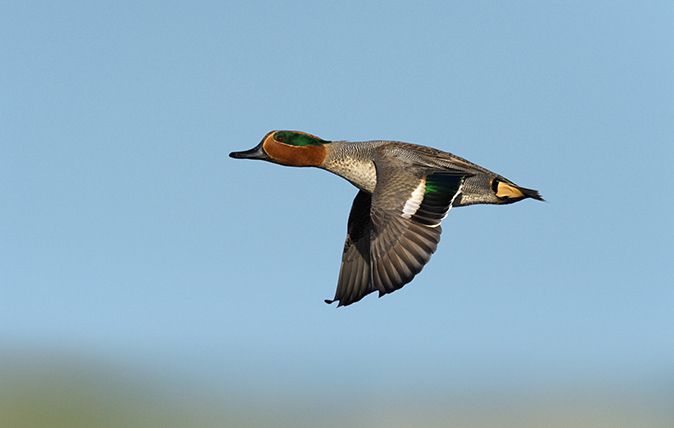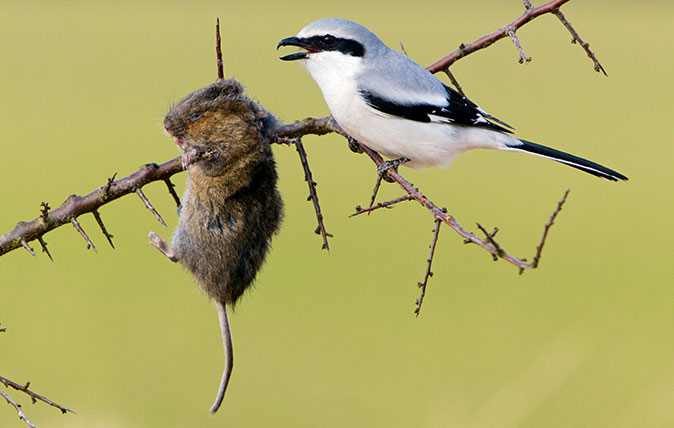David Profumo takes a look at the teal, the mighty duck that's as devastatingly impressive soaring through the air as it is hilariously ungainly when waddling on dry land.
Sprightly and trim, the Eurasian teal is a plumose pocket rocket – a petite dabbling duck, the drake of which sports a head as gaudy as some tribal pom-pom in time for the courtship season that begins in October.
Widely distributed across the northern parts of Britain, our resident population of Anas crecca is augmented during the winter months by considerable numbers of passage migrants from Scandinavia and western Russia, where it still abounds. Key wintering sites include the Somerset Levels, Mersey estuary and – before reafforestation schemes altered the terrain – the Flow Country in Scotland. Teal favour wetlands, bog, taiga and remote heaths, but will readily migrate to softer southern conditions during periods of freezing weather.

Lightly built, with a wingspan of less than 2ft, the teal used to be known by poulterers as a ‘half-bird’ and only the garganey is similarly small. During August, the male moults and assumes a flightless eclipse plumage, but his autumn finery is intricate and striking. The head is bright chestnut, with an emerald eyestrip running to the nape.
His mantle and flanks are pencilled with a delicate grey-and-white vermiculation (prized by fly-dressers for patterns such as Teal, Blue and Silver) and the back is indeed of tarnished silver. Their plumage exhibits strong sexual dimorphism – the female being brownish, like a miniature mallard – but both show, on the trailing edge of their wings, a distinctive patch of metallic green (the speculum). The duck also has a pinker bill.

A teal pair (Anas crecca) feeding
Like gadwall and wigeon, they feed in shallow water and, in the Autumn, the teal is a nocturnal forager. The autumn diet is chiefly vegetable or granivorous – seeds, roots of water plants, algae and duckweed. They require some 20g of fodder each day. Paddling and upending allows them to keep eyes above the surface to avoid predators, such as peregrines and buzzards, but to pike they can be, literally, sitting ducks.
The bill has a filtration system aided by toothy ridges (lamellae) that function as sieves, with the tongue acting like a piston. Siphoning up sediment, they also ingest grit and gastroliths that assist digestion in the gizzard, which makes them susceptible to lead poisoning from wildfowlers’ spent shot. Before the lead ban, one zone in the Camargue recorded a density of two million lead pellets per hectare.

‘Drunk as a duck’ proverbially describes the less-than-nimble gait of a teal on land, but it is masterful on the wing. When flushed, it has a characteristic way of rising almost vertically from the water – one collective noun is a spring, another a coil – thereafter executing corkscrew swerves and sudden wheels like a wader, and exceeding speeds of 50mph.
Outside of the breeding period, they are gregarious. The name ‘teal’ remains, most unusually, unchanged since medieval times and, like crecca (which derives from the Swedish), is an onomatopoeic version of the male’s soft, fluty double whistle – krit krit – a far-reaching voice that is sometimes replaced by an alarm call like a lapdog’s yelp.
It remains uncertain whether or not teal mate for life, but pair formation begins after the summer ends, and pre-copulatory displays include enthusiastic bill-dipping, mock preening, jump flights, chin-lifting and nod-swimming. The drake possesses a penis and breeding in spring is by intromission (as opposed to cloacal contact), sometimes violently enforced upon the female. Nests are scrapes in the ground lined with grasses and bracken; a single clutch of 8–10 greeny-buff eggs is laid in late April and incubated by the duck alone.

The drake may loiter awhile or scoot off in search of extra-pair copulation, after which he enters the moult. The ducklings, which are nidifugous and independent, fledge after three weeks, but the survival rate is sadly low due to predation by mink and fox.
For centuries valued as a dainty dish of meat, teal were a feature of Egyptian funerary art (many wildfowl having being sacred to Isis) and their bones have been discovered in Roman middens here. There is a fine mosaic of a male teal at the House of the Faun in Pompeii.
In Victorian times, they were harvested in vast numbers by professional punt-gunners and net-trapped with live decoys. During the Raj, they were specially fattened for the table in teal houses. Until the onset of avian bird flu, duck-blood soup – Czarnina – was a favourite Polish dish at Easter. My preferred recipe is to coat the bird with olive oil, sprinkle it with coarse salt, roast it breast up and serve with wild rice and an orange-and-watercress salad – one brace per diner. This is a dish worthy of Isis.
Duck grease was once a popular ingredient in folk medicine. In his A Medicinal Dispensatory of 1657, Jean de Renou recommends it for ‘dolour of the joynts’ and ‘cold distemper of the nerves’. But let’s face it: he was probably a quack.

Where, when and how to spot an otter in the wild
Otters can live in most places where there is a rocky shoreline and nearby freshwater, but these tips collated by

Beware the Great Grey Shrike: The pretty songbird with the temperament of Vlad the Impaler
Simon Lester takes a look at the great grey shrike, a delicate-looking songbird whose innocent appearance belies its sadistic tendencies

From Drunken Ducks to Unruly Pigs: British pubs with quirky animal names
The British love animals, and we love pubs. What could be better than a combination of the two?





